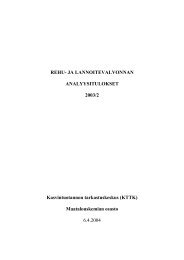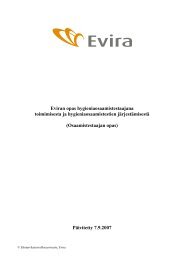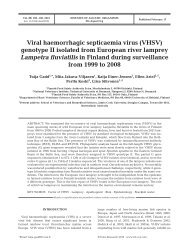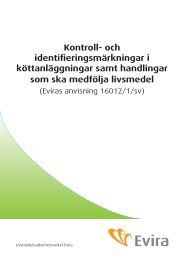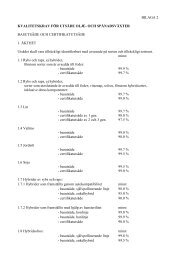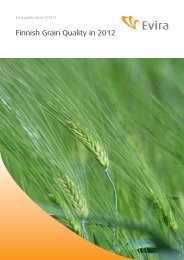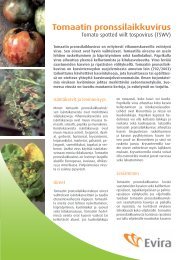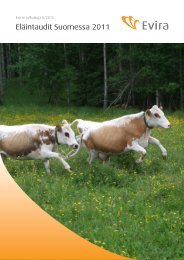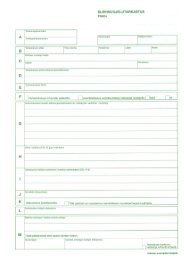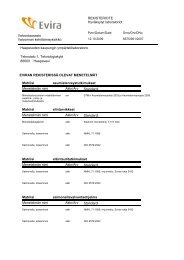Download PDF, 1522 kB - Evira
Download PDF, 1522 kB - Evira
Download PDF, 1522 kB - Evira
Create successful ePaper yourself
Turn your PDF publications into a flip-book with our unique Google optimized e-Paper software.
y serotypes S. Infantis and particularly S. Agona prevailed among certain cattle<br />
for years. Serotype S. Enteritidis was only isolated in individual cases over the<br />
years, but even this has had a tendency to remain within a herd for a long. After<br />
becoming infected by S. Typhimurium, cattle are generally cleaned of infection<br />
within a few months. No multi-resistant strains of Typhimurium DT 104 were<br />
isolated at cattle farms after 1997. Infection with Typhimurium DT 41, typical<br />
for wild birds and particularly seagulls, did not appear to very easily spread to<br />
cattle; generally, this has no longer been isolated from repeated samples, and<br />
disinfection of infection with Typhimurium DT 41 appears to rapidly take effect.<br />
A large proportion of other individual serotypes have also rapidly disappeared<br />
and have often only been isolated once. Serotype Poona, causing human infection<br />
via raw milk in 1996 to 1997, has repeatedly been isolated from fur-animal<br />
feedstuffs. Cattle or pig farms may be located in the vicinity of fur farms or be<br />
run by the same owner, and the risk of spread of disease must then be taken<br />
into account at these at farms.<br />
The expanding unit sizes among cattle farms, as well as increasiang frequency<br />
of freestall dairy barns and three-stage rearing units in meat production have<br />
presented new challenges in the prevention of Salmonella. Animals moving<br />
freely in freestall barns run a greater risk of becoming infected under disease<br />
conditions and their disinfection may then be more difficult than for cows in tie<br />
stall barns. Hence, disease prevention must receive particular attention.<br />
Calves may arrive at calf-rearing units from 30 to 40 farms. Isolating the original<br />
source of Salmonella infection is then laborious, expensive and often impossible.<br />
Disinfection of these farms is also demanding because of the risk of repeated<br />
infection if no separate facilities are available where decontaminated animals<br />
can be transferred to. Even then, while samples are being analyzed for Salmonella,<br />
disinfected animals may become re-infected before being transferred to a<br />
separate place when the results are ready. In addition, the planning of sampling<br />
requires a great deal of thought when the number of individuals is large.<br />
While the National Salmonella Control Programme has been in effect, Salmonella<br />
has only been isolated in swine as individual cases. However, Salmonella has<br />
more often been detected in lymph nodes from pigs than in faecal samples from<br />
farms. Lymph nodes have also carried out three times the number of serotypes<br />
in relation to faecal samples. Generally, as pigs excrete little Salmonella in their<br />
faeces, finding infections in live animals is very difficult, and analysis of faeces<br />
will not always reveal infections. Analysis of lymph nodes is therefore more efficient<br />
than faecal sampels for controlling Salmonella infections in pigs. In EU<br />
countries, where infection is abundant, survey research and efforts to reduce<br />
occurrences are applying analysis of meat fluids through serological methods<br />
carried out at slaughterhouses. Although these are considered cost-efficient methods<br />
for screening, serotype data are necessary for epidemiological monitoring<br />
and hence, to that end, bacteriological isolations are necessary.<br />
As pig-producing units are also increasing in size, quantifying the number of<br />
animals to be extended increasingly demands evaluation to reveal subliclinical<br />
infections, particularly because of the poor secretion in faeces. Symptomless<br />
infections in holdings of hundreds of sows may quickly spread infection to several<br />
fattening units. This has so far been avoided, and preventive actions are<br />
of essential importance. Through efficient cleaning and disinfecting actions, the<br />
few Salmonella-positive herds have mostly been cleaned relatively rapidly. In<br />
locations where infection has prevailed for longer, deficiencies in the implementation<br />
of the disinfection plan have been observed.<br />
Salmonella control and occurence of Salmonella from 1995 to 2004



